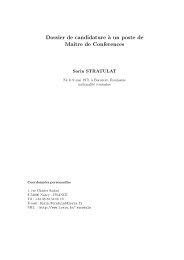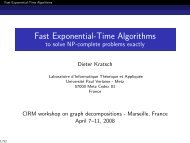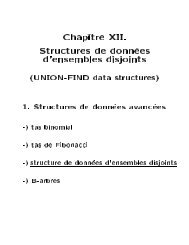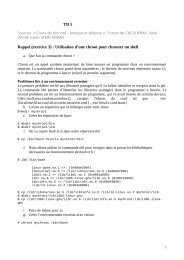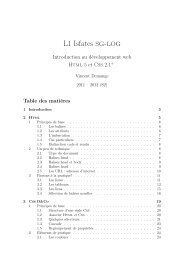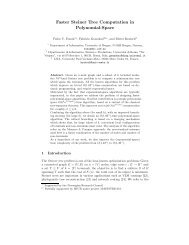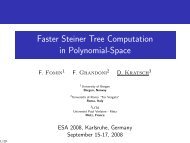Iterative Compression and Exact Algorithms - Lita
Iterative Compression and Exact Algorithms - Lita
Iterative Compression and Exact Algorithms - Lita
Create successful ePaper yourself
Turn your PDF publications into a flip-book with our unique Google optimized e-Paper software.
In Step 2, we reduce the problem of finding a maximum sized C to theproblem of finding a maximum weight matching in an auxiliary bipartitegraph. Independent of our work, Hüffner et al. [17] also use this natural ideaof reduction to weighted bipartite matching to obtain an FPT algorithm forthe vertex weighted version of Cluster Vertex Deletion using iterativecompression. For completeness, we present the details of Step 2.If G[N] contains an induced P 3 then there is obviously no C ⊆ V inducinga cluster graph that respects the partition (N, ¯N). We call such apartition invalid.Otherwise, G[N] is a cluster graph, <strong>and</strong> thus the goal is to find a maximumsize subset C of S = V \ S such that G[C ∪ N] is a cluster graph.Fortunately, such a set C can be computed in polynomial time by reducingthe problem to finding a maximum weight matching in an auxiliary bipartitegraph.First we describe the construction of the bipartite graph. Consider thegraph G[N ∪ S] <strong>and</strong> note that G[N] <strong>and</strong> G[S] are cluster graphs. Now thefollowing reduction rule is applied to the graph G[N ∪ S].(R) Remove every vertex b ∈ S for which G[N ∪{b}] contains an inducedP 3 .Clearly all vertices removed by (R) cannot belong to any C inducing acluster subgraph of G. Let Ŝ be the subset of vertices of S which are notremoved by (R). Hence the current graph is G[N ∪ Ŝ]. Clearly G[Ŝ] isa cluster graph since G[S] is one. Further, note that no vertex of Ŝ hasneighbors in two different maximal cliques of G[N] <strong>and</strong> if a vertex of Ŝ hasa neighbor in one maximal clique of G[N] then it is adjacent to each vertexof this maximal clique. Thus, every vertex in Ŝ has either no neighbor in Nor it is adjacent to all the vertices of exactly one maximal clique of G[N].Now we are ready to define the auxiliary bipartite graph G =(A, B, E ).Let {C 1 , C 2 , ··· , C r } be the maximal cliques of the cluster graph G[N]. Let{C1 , C 2 , ··· , C s} be the maximal cliques of the cluster graph G[Ŝ]. Let A ={a 1 ,a 2 ,...,a r ,a 1 ,a 2 ,...,a s} <strong>and</strong> B = {b 1 ,b 2 ,...,b s }. Here, for all i ∈{1,...,r}, each maximal clique C i of G[N] isrepresentedbya i ∈ A; <strong>and</strong> forall j ∈{1, 2,...,s}, each maximal clique Cj of G[Ŝ] isrepresentedbya j ∈ A<strong>and</strong> by b j ∈ B.Now there are two types of edges in G : a j b k ∈ E if there is a vertexu ∈Ck such that u has a neighbor in C j, <strong>and</strong> a j b j ∈ E if there is a vertexu ∈Cj such that u has no neighbor in N. Finally we define the weightsfor both types of eges in the bipartite graph G . For an edge a j b k ∈ E ,itsweight w(a j b k ) is the number of vertices in Ck being adjacent to all verticesof the maximal clique C j . For an edge a j b j, its weight w(a j b j)isthenumberof vertices in Cj without any neighbor in N.This transformation is of interest due to the following claim that usesthe above notation.13



